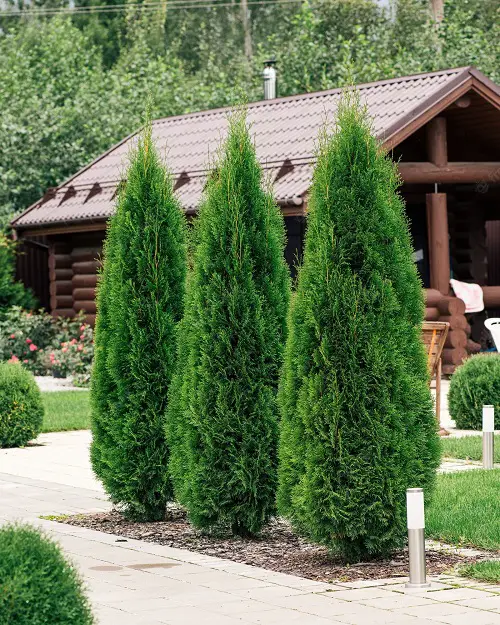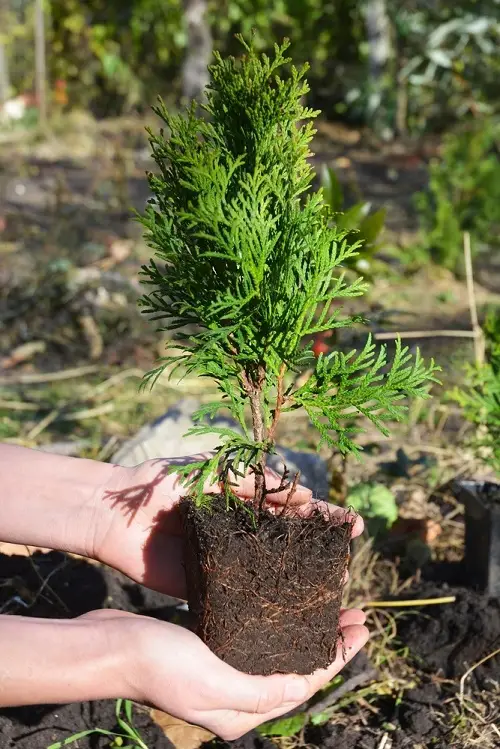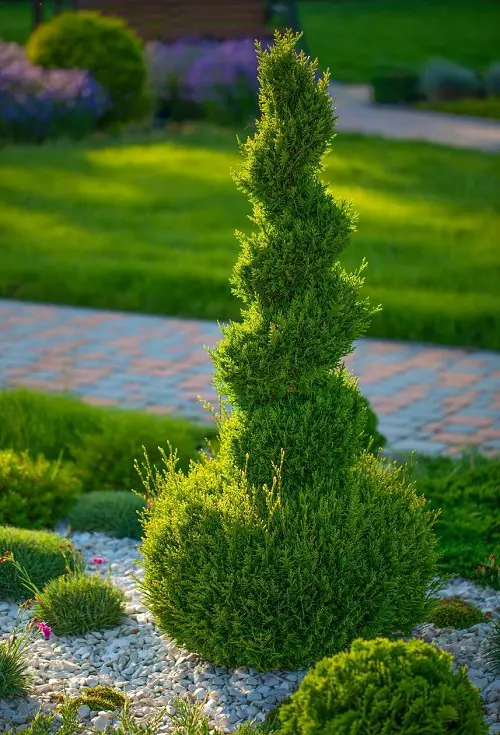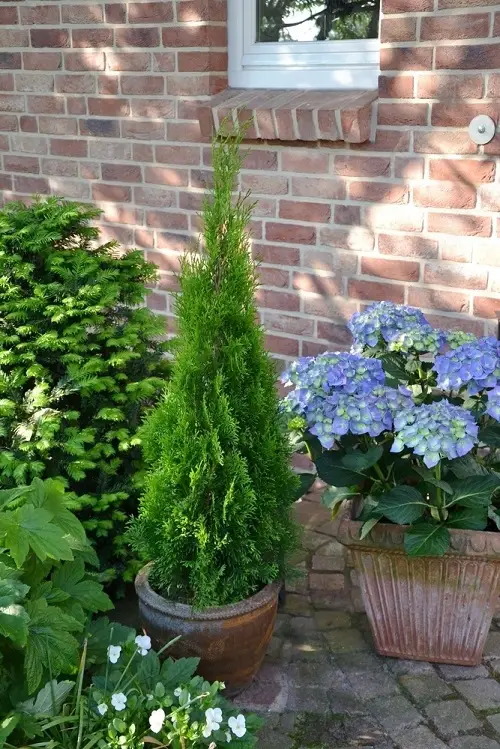Here’s a detailed guide on How To Plant Thuja easily – which also happens to be one of the best plants as a living privacy screen!
If you are looking for a standalone privacy hedge, then this plant is your best bet. Learn all the tips on How To Plant Thuja and maintain this beautiful specimen for a long time to come.
Best Varieties of Thuja
Here are some popular varieties of Arborvitae (Thuja) commonly grown in the United States:
- Green Giant Arborvitae (Thuja standishii x plicata ‘Green Giant’): This is one of the most popular and fastest-growing varieties. It has a dense, pyramidal shape, with rich green foliage that retains its color throughout the year. It is an excellent choice for privacy screens and windbreaks.
- Emerald Green Arborvitae (Thuja occidentalis ‘Smaragd’): This variety is known for its narrow, columnar shape and vibrant emerald green foliage. It grows relatively slowly and maintains a compact size, making it ideal for small yards or as a hedge plant.
- Techny Arborvitae (Thuja occidentalis ‘Techny’): This variety has a dense, conical shape and dark green foliage. It is a hardy and adaptable variety that tolerates a wide range of soil conditions. Techny Arborvitae is often used for hedges, screens, and foundation plantings.
- American Arborvitae (Thuja occidentalis): This is the native species of Arborvitae in North America. It has a tall, narrow form and soft, scale-like foliage that ranges in color from deep green to yellow-green. It is commonly used for windbreaks and as a specimen tree.
- Nigra Arborvitae (Thuja occidentalis ‘Nigra’): This variety features dark green foliage that turns bronze or plum-colored in winter, adding visual interest to the landscape. It has a compact, pyramidal shape and is often used as a specimen or accent plant.
- North Pole Arborvitae (Thuja occidentalis ‘Art Boe’): This dwarf variety has a dense, globe-shaped form and maintains its deep green foliage year-round. It is well-suited for small gardens, rock gardens, or container planting.
How To Plant Thuja Easily
Arborvitae (Thuja) can be propagated through several methods, including seed propagation, cuttings, and layering. Well, cuttings is the easiest and fastest method for it!
Stem Cuttings:
- Take semi-hardwood cuttings in late summer or early fall. Choose healthy, non-flowering shoots from the current year’s growth.
- Cut 4-6 inch (10-15 cm) long stem cuttings just below a leaf node, using clean and sharp pruning shears.
- Remove the lower leaves from the cuttings, leaving only a few sets of leaves at the top.
- Dip the cut end of the stem in a rooting hormone powder or gel to promote root development (optional).
- Fill a pot or tray with a well-draining rooting medium, such as a mixture of peat moss and perlite.
- Insert the cuttings into the rooting medium, leaving at least one node buried in the soil.
- Mist the cuttings and cover the pot or tray with a plastic bag or a propagation dome to create a humid environment.
- Place the container in a warm and bright location with indirect light.
- Keep the rooting medium consistently moist but not waterlogged.
- Roots should start forming in several weeks to a few months. Once the roots have developed, the cuttings can be potted up or transplanted into the ground.
Requirements for Growing Thuja
Sunlight
Thuja generally prefers full sun to partial shade for optimal growth. Full sun exposure (at least 6-8 hours of direct sunlight per day) promotes better foliage color, density, and overall growth.
However, some varieties, such as Emerald Green Arborvitae, can tolerate partial shade as well.
Soil
Thuja thrives in well-draining soil that is rich in organic matter. The ideal soil pH for most varieties is slightly acidic to neutral, ranging from 6.0 to 7.5. However, Thuja is adaptable to a wide range of soil types, including loam, sandy loam, and clay soils.
The key is to avoid waterlogged or excessively compacted soil, as it can lead to root rot or other issues.
Water
Established Thuja trees are relatively drought-tolerant, but they still require regular watering, especially during the first year or two after planting. Provide deep, thorough waterings to promote deep root growth rather than frequent shallow watering.
During dry periods, water the tree once a week, ensuring the soil remains evenly moist but not overly saturated. Avoid overwatering, as excessive moisture can cause root rot.
Temperature Range
Thuja is generally hardy and can tolerate a wide range of temperatures. Most varieties are suitable for USDA hardiness zones 3 to 8, although specific varieties may have different tolerances.
They can withstand cold winter temperatures and also tolerate heat and humidity. However, extreme temperature fluctuations or prolonged periods of extreme heat or cold can stress the plants.
In colder regions, Thuja appreciates protection from strong winds and heavy snow loads, especially when young. Mulching around the base of the tree can help insulate the roots and protect them from temperature extremes.
Thuja Care
Fertilizer
Generally, Thujas’ do not need to be fertilized, but you can boost their growth using a liquid fertilizer. A formula of 10-10-10 or 14-14-14 is perfect.
Feed the plant in early spring before new growth begins or in early fall to help prepare the tree for winter. Dilute it to 1/2 of its recommended strength. Avoid fertilizing during hot summer months, as this can stress the plant.
Pruning
Pruning Thuja is typically done for shaping, maintaining size, or removing damaged or diseased branches.
Do it in late winter or early spring, before new growth starts. Pruning during this time allows the plant to heal and recover before the active growth period. Remove any dead, broken, or diseased branches as soon as you notice them. Make clean cuts just outside the branch collar (swollen area at the base of the branch).
If you want to shape or maintain a specific size, selectively prune the branches, keeping the natural form of the tree in mind. Avoid heavy pruning that removes a significant portion of the tree’s foliage.
Use clean, sharp pruning shears or loppers to make precise cuts.
Pests and Diseases
Thuja is generally resistant to most pests and diseases, but it can still encounter some issues. Here are a few common problems:
- Bagworms: These pests can cause defoliation. Handpicking the bags or using insecticidal sprays can help control infestations.
- Spider Mites: These tiny pests can cause yellowing or bronzing of the foliage. Regularly spraying the tree with a strong stream of water can help keep populations in check.
- Canker Diseases: Certain canker diseases can affect Thuja, causing sunken or discolored areas on the branches. Prune infected branches back to healthy wood and dispose of the debris.
- Root Rot: Overly wet or poorly drained soil can lead to root rot. Ensure proper drainage and avoid overwatering to prevent this disease.







a 15-30-15 fertilizer is recommended where do I find this? will fish emulsion work
Hi
We are looking at buying 10 x plants currently 8ft tall and re siting in our garden as ready made screening. Any help please on removal from current site , transporting and replanting.
Many thanks.